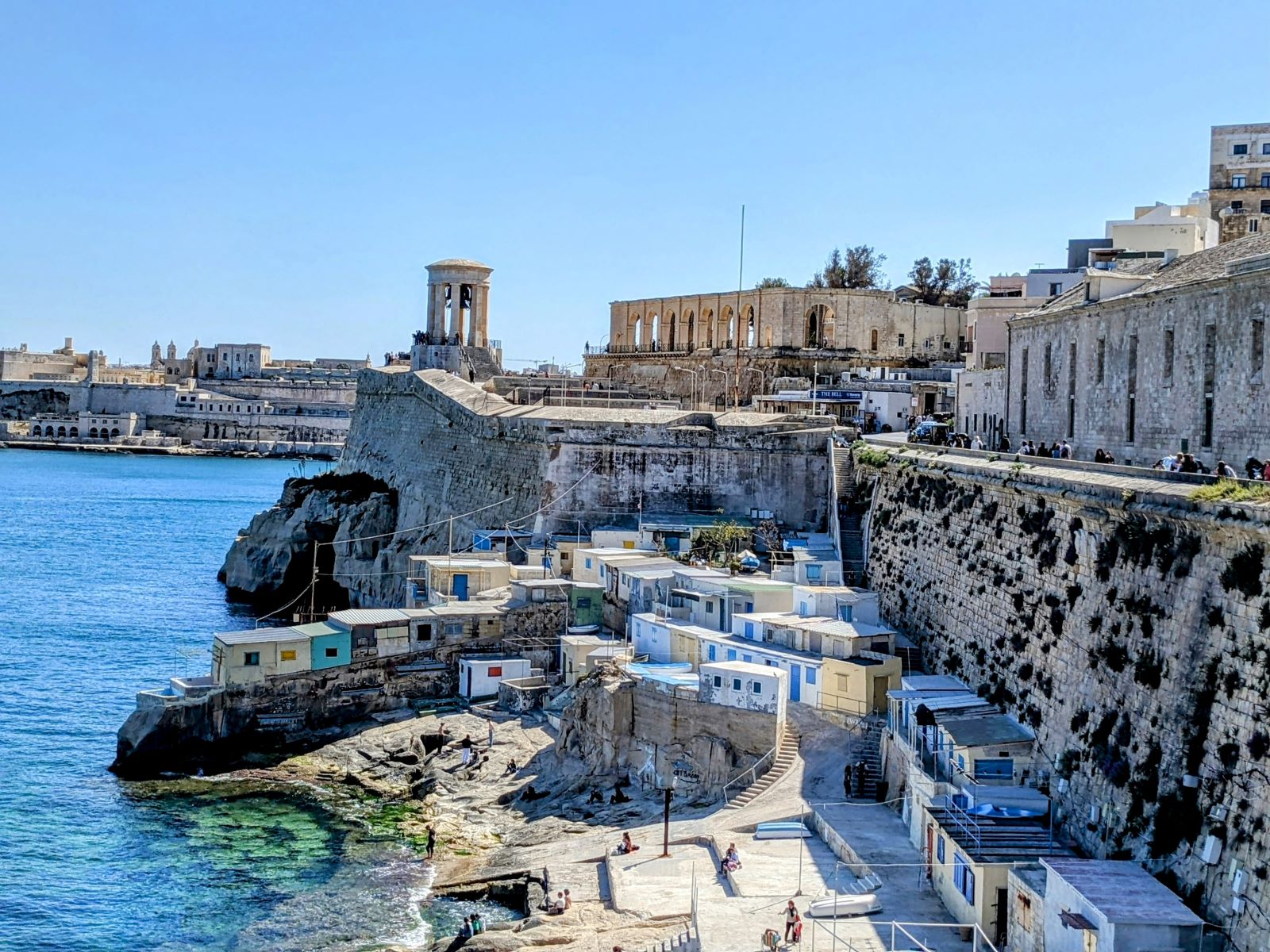
“Bil-qatra I-gatra timtela l-garra,” a Maltese proverb tells us. “Drop by drop, the pot fills up.” And so it was when I visited Malta. Each day, a new experience, new knowledge, new awe until by the end of my time there, I felt quite full – still realizing there remains ample room in the pot for further drops. I guess a sign of any good holiday is the notion that you’d like to return, and that’s certainly true for me.
I find I have a certain perspective when I travel. I am more interested in learning about culture and history, less interested in vacation pursuits of beaches, food and drink (although food can intrigue me, plus sun on my Irish bones is always welcome). And so it is with Malta. That doesn’t mean you won’t get your fair share of places to consider visiting, because you will. I just tilt in a certain direction. So you are forewarned, dear readers!
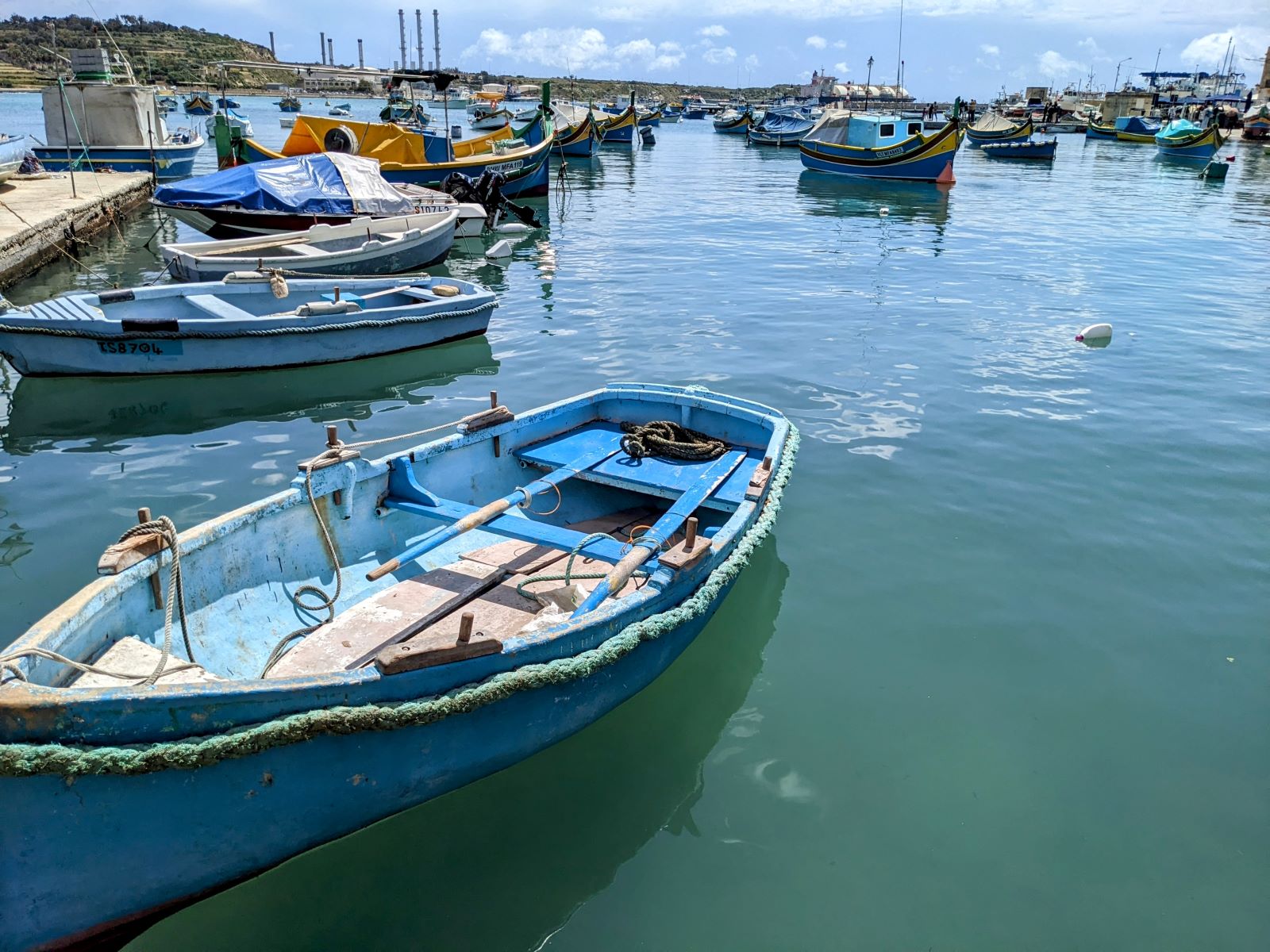
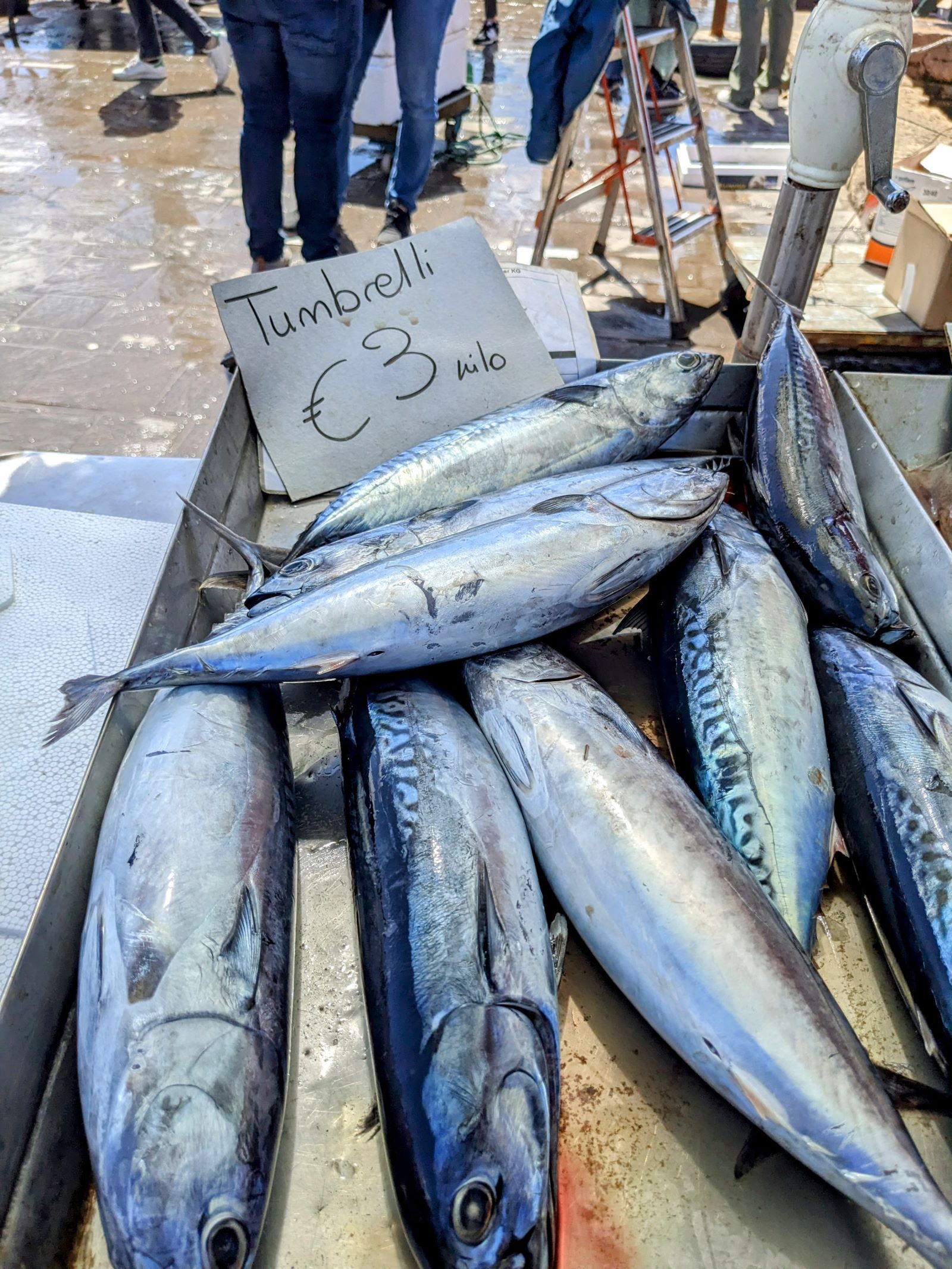
FOR YOUR INFORMATION: If you are in Malta on a Sunday, I’d recommend a trip to the lovely seaside town of Marsaxlokk. Several folks told me to visit the Sunday market, which wends its way down along the promenade. It’s known for its fish stalls, and they were plentiful and full, so if you have cooking facilities where you’re staying, you’d be hard pressed not to avail. But there are also plenty of fruit and veg stalls and tourist-type stalls, too. Gaze out at the colorful luzzu fleet – blue and yellow painted ships believed to date to the Phoenicians. And by all means, have a bite of seafood at any of the many restaurants.
Let’s put Malta in some context, because I am not sure many people know much about it. I certainly didn’t. It is an island nation, comprised of six islands but only two that are populated: Malta, the primary island, and Gozo. (A third, Comino, apparently has two year-round residents.) It is only 58 miles south of Sicily, Italy, and 179 miles north of North Africa in the Mediterranean Sea. It’s been an independent nation since 1964, when it left the British empire. The capital is Valletta, which has a population of around 6,000 people, although it looks and acts for all the world like a much, much larger, more cosmopolitan city; the entire nation has a population of just under 500,000.
The country has a long history, reaching back to about 5,000BC, according to archaeological evidence. More about this fascinating prehistoric period in a moment. Once nations started moving around more broadly, because of Malta’s location it is not at all surprising that it was invaded and invaded and invaded again, depending on the whims and demands of the conquerors.
The invasions began with the Phoenicians, who colonized it in 700BC and remained in control until 218AD, when the Roman Empire took over. Since then, it has been in the control of: the Byzantines (535); North African Muslims (870AD); the Normans (1091); Spain (1282); the Knights of St. John, a military religious order (1530); the French under Napoleon Bonaparte (1798) and finally the British in 1800. The first day we arrived, we saw a very grand film on a huge screen that explains all this, called The Malta Experience; although pricy (€16 for adults), I would highly recommend going. https://themaltaexperience.com/
Frankly, this knowledge about the history of Malta floored me, although it shouldn’t have. The reason I try to travel as often as finances and time allow is to begin to fill in the huge swaths of blank spaces in my knowledge of the world. First of all, I did not have the wherewithal to travel much during my working lifetime. But also, I think I suffer from a bit of Americanitis. By that I mean that America tends to be an insular nation. We wrap up in our own culture, our own country, our own politics, our own young age. Most of us probably took a World History class sometime in high school, and if our interests and proclivities didn’t draw us toward a fuller understanding later in life, that was probably about the extent of our knowledge. And speaking for myself, I never appreciated what I was missing until I moved to another country. So I really do try to absorb history into my traveling pores whenever possible.
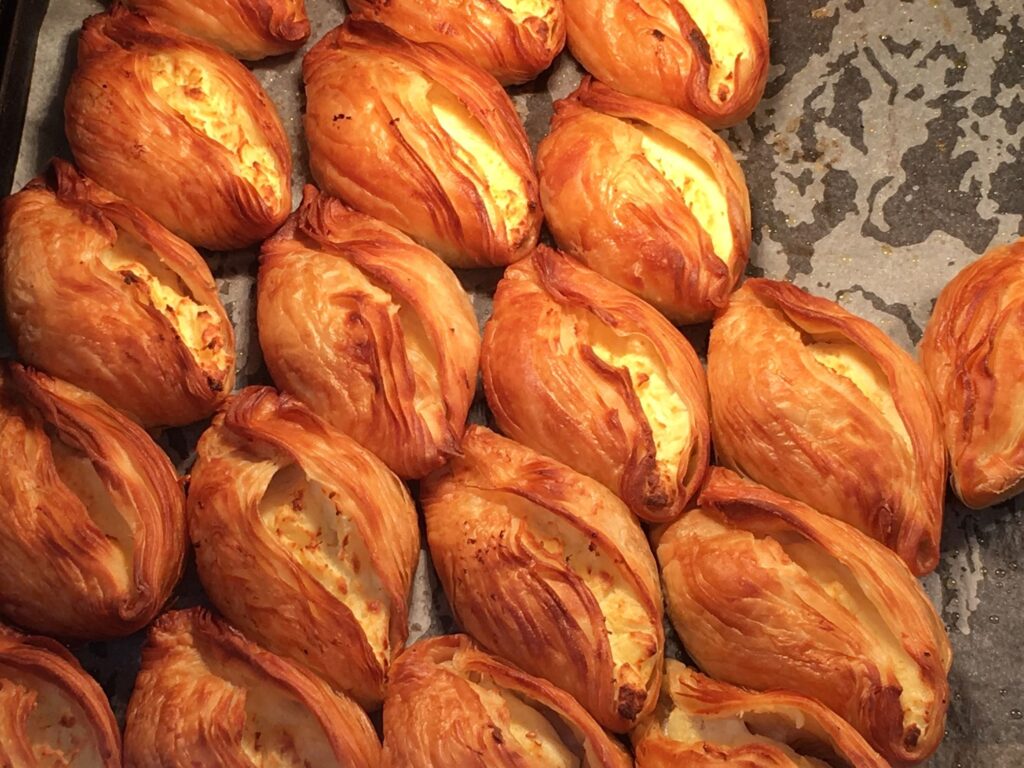
FOR YOUR INFORMATION: Valetta is not wanting for places to eat, bars at which to drink and shops to visit. The two primary streets for all such things are Republic Street and Merchant Street. Here, you will find everything from chintzy souvenir shops to upscale jewelry and clothing stores. But do explore the side streets, where cafes are tucked away. And while you are there, be sure to track down one of the small street-front pastry makers and avail of a pastizzi or two – a delight of puff pastry stuffed with ricotta cheese or curried peas and piping hot. Each one will set you back a little over €1.
I think two broad groups of cultural visitors would find Malta particularly appealing: those with an interest in archaeology and those with an interest in the Roman Catholic church.
As you may recall from earlier posts, I am enrolled in a two-year diploma program in Irish archaeology through the University of Galway. I have completed year 1, an intensive survey course beginning with the Neolithic and ending in the Medieval period – a lot of learning! So perhaps it’s not surprising that I was drawn to Malta’s prehistoric sites.
In particular, I was interested in the “Temple Period,” which began very distinctly around 3600BC and ended just as suddenly around 2500BC.* Scattered across Malta and Gozo, seven megalithic temples have been discovered, several of which have been recognized as UNESCO World Heritage sites. For instance, the temples at Ggantija in Gozo, built around 3600BC, are considered the oldest surviving free-standing monuments in the world, predating the pyramids and Stonehenge by 1,000. They are older even than Newgrange in Ireland, which dates to 3200BC. All evidence points to the fact that the people who inhabited Malta during this time were intelligent, resourceful and religious. In fact, experts have drawn the conclusion that Malta may have been a “sacred island” for regional prehistoric communities. What happened around 2500BC is unknown. Were they invaded and killed? Was there a pandemic? Could it have been a climate event? But archaeologists don’t pick up the thread of finds again until the later Bronze Age.
I will tell you straight out that I barely sated my interest in the temples while I was in Malta. Most are in remote locations that required advanced planning in order to avail of bus service or even to be able to enter them. In the latter regard, one of my big regrets was that I was unable to visit the Hal Saflieni Hypogeum, a three-level, intricate underground burial complex where the remains of about 7,000 individuals have been found, along with possessions and votive offerings. Because of its delicate condition, only 10 visitors are allowed inside each hour so it books up months in advance. I didn’t know this, but now you do.
For information on Hal Seflieni and other temple and prehistoric and some Christian sites, and to pay for tickets, visit the Heritage Malta website, https://heritagemalta.mt/
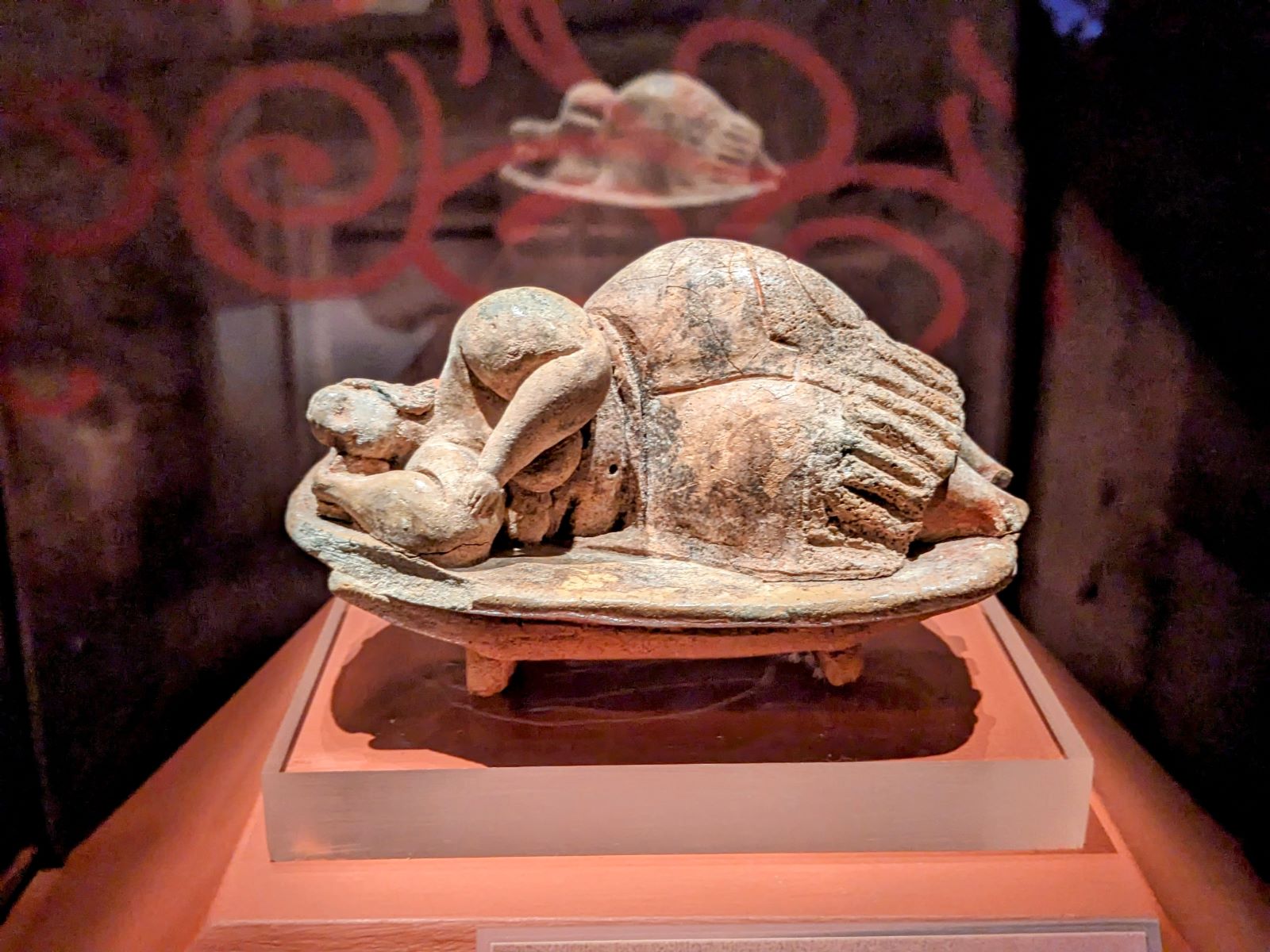
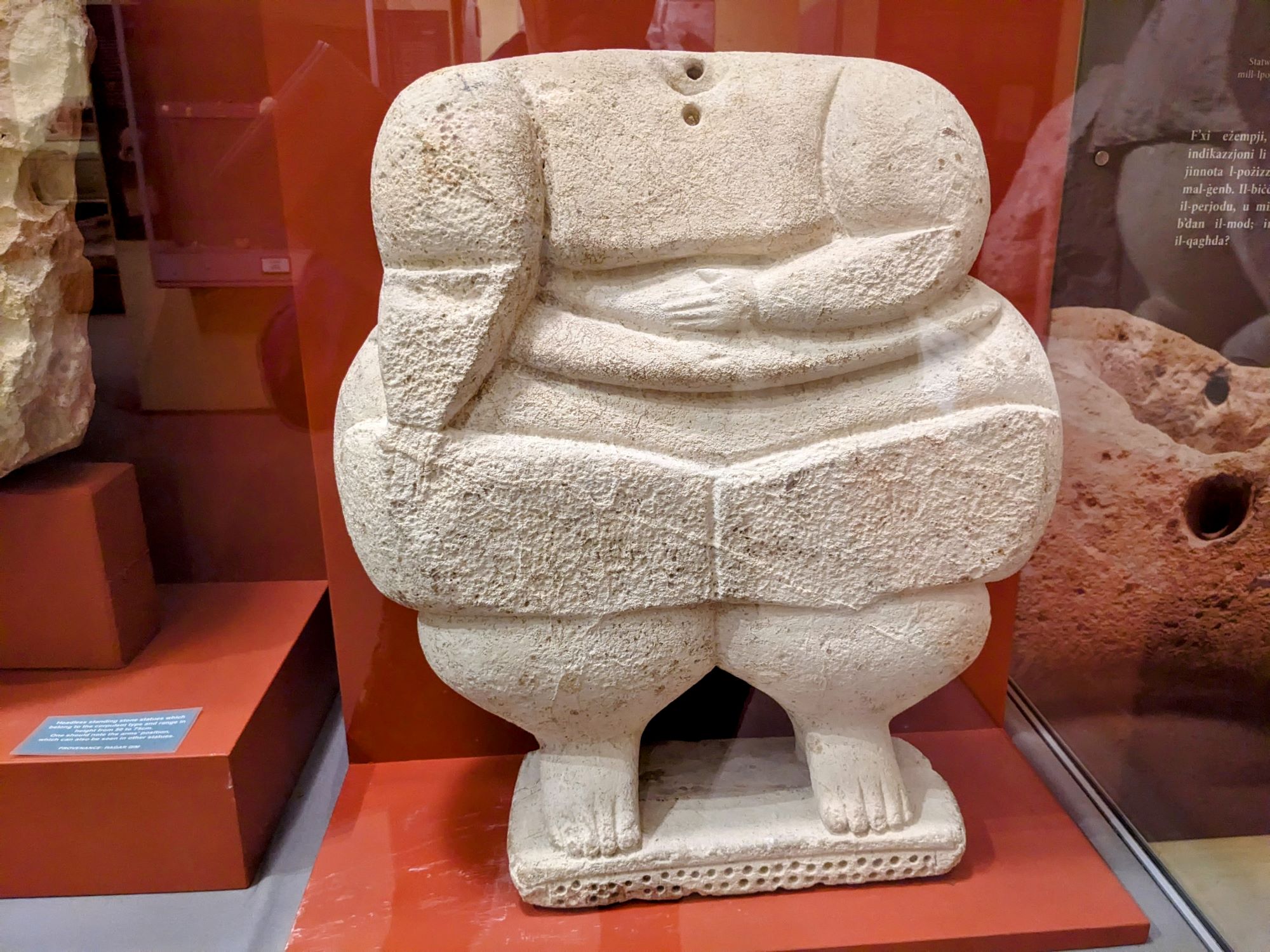
The sleeping lady, left, is a quite tiny figurine that was found at the Hal Seflieni Hypogeum. At right, this is one of several deity statutes found at Hagar Qim. None of them had heads but you can see the holes at the top of the statue. This leads to speculation that the heads could have been replaced on a regular basis, perhaps made of wood that over time would disintegrate. The picture below depicts three enormous standing stones at the Hagar Qim Temple, the one on the left at 21 feet tall.
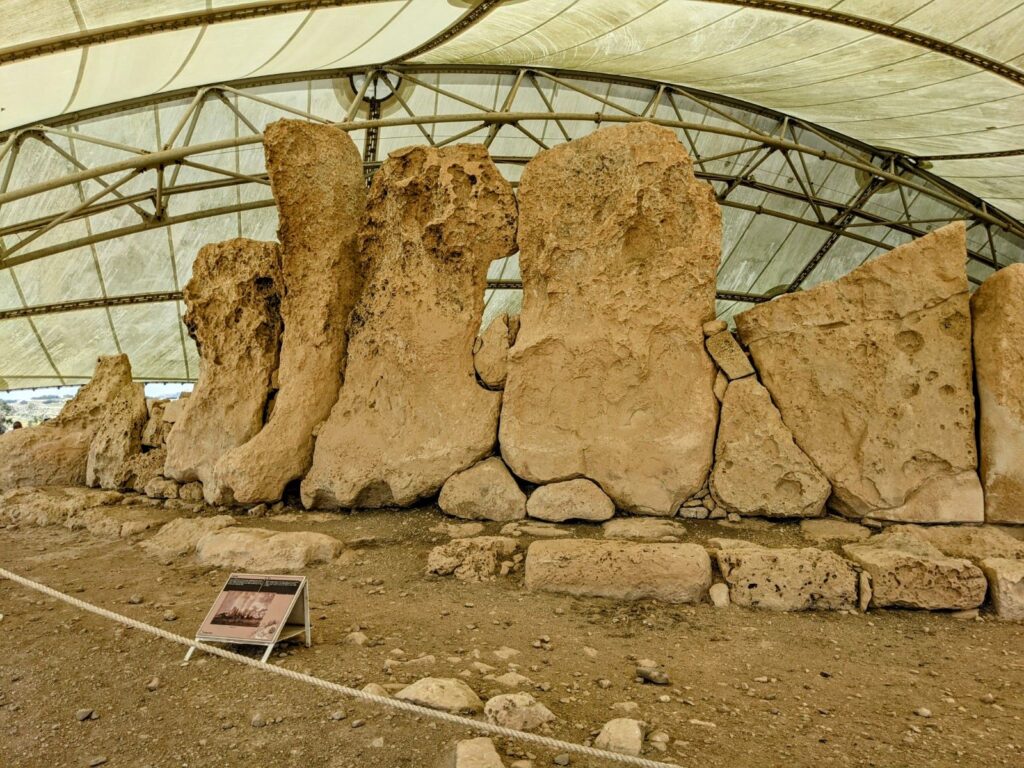
I did visit the Hagar Qim (translated as ‘standing’ or ‘worshipping’ stones) temple complex, set high upon a hill overlooking the Mediterranean. The Maltese government covered this and other temple sites with huge tents to preserve them from the elements. Made of limestone, the main temple consists of a forecourt with a central passage leading to a number of apses. It was built in several phases over many years. Monuments of standing stones – and there are a good few of them here in Ireland – are amazing engineering feats, and Hagar Qim is the most impressive of any I’ve seen. The structure of the temple is well preserved. Among the stones comprising the outer wall is one that is 21 feet tall and is estimated to weigh close to 20 tons! Imagine the skill and ingenuity it took to transport this stone to the site and to erect it. Inside, a number of deity statues were discovered, now in the National Museum of Archaeology, that were long considered goddess figurines though now are assumed to be asexual. (Having seen them, I stick with the female interpretation!) Again, visit the Heritage Malta website for times, costs and tickets to Hagar Qim.
I’d like to go back to Malta and concentrate exclusively on the temples and other prehistoric sites. Not everyone’s cup of tea, but certainly mine.
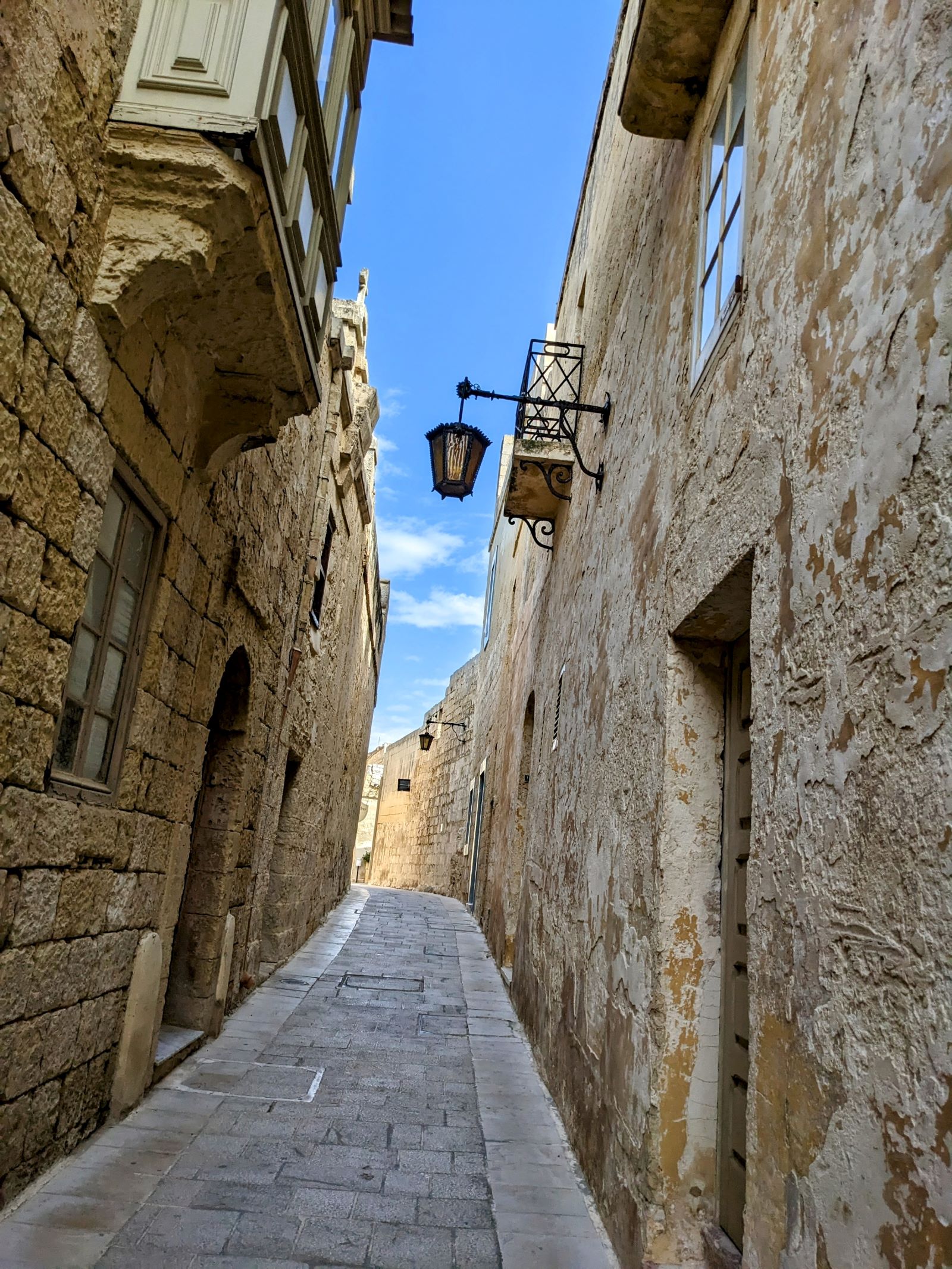
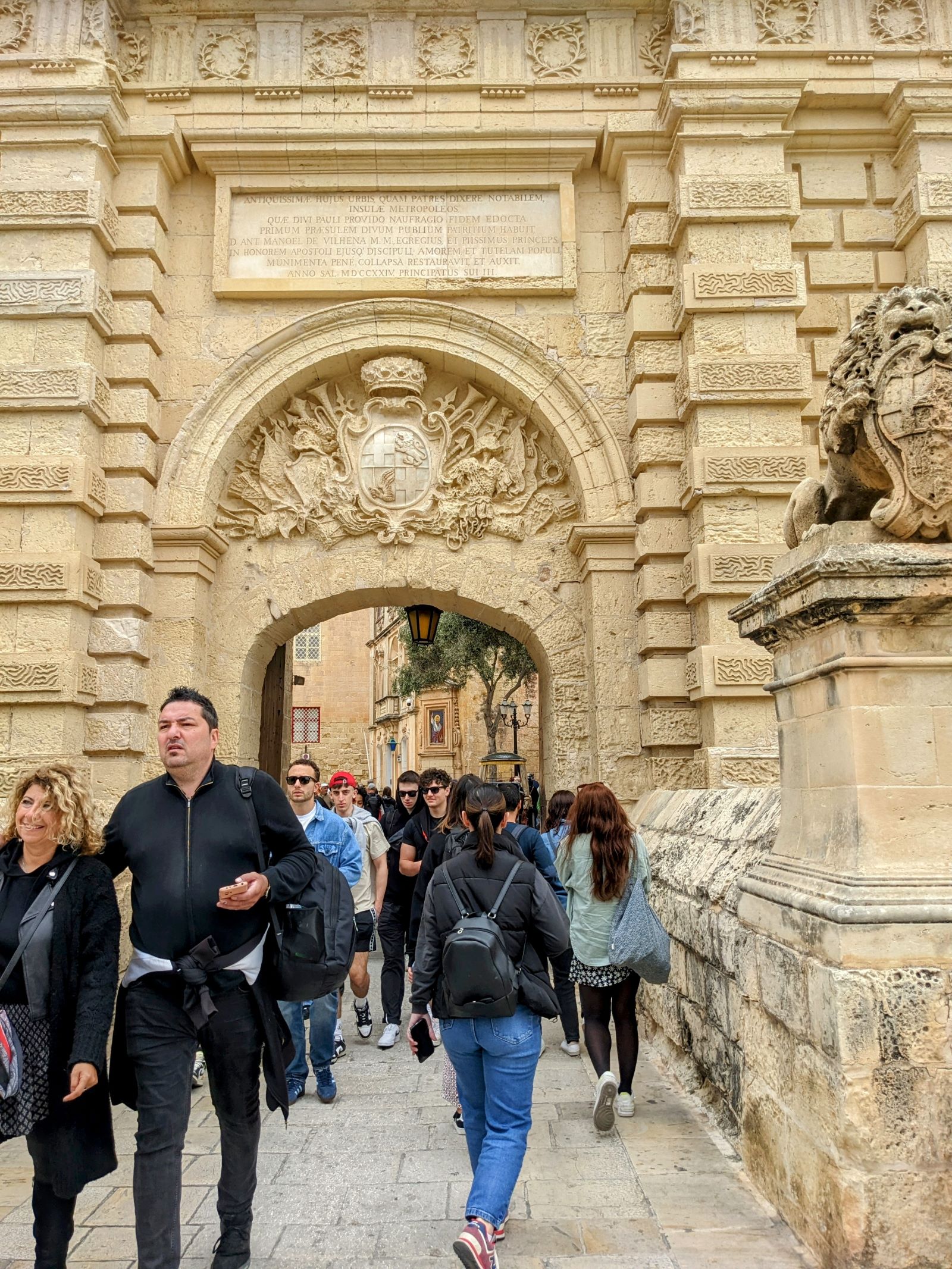
FOR YOUR INFORMATION: Make it a point to visit the ancient walled capital of Mdina, founded by the Phoenicians in the 8th century BC. I’ve never seen anything like it before, with its narrow pathways and intriguing architecture. And because only residents can bring cars inside, it’s essentially given over to pedestrians. At right is the Mdina Gate, the entry into the city.
Perhaps a cup of tea that would interest others is the influence of Christianity and specifically the Catholic Church on the nation. Malta is an extraordinarily Catholic country. There are 359 Roman Catholic churches, attended by 82.6 percent of the population (according to the 2021 census). Truly, in Valletta, there is a church just about every block. I traveled to Malta with a Catholic friend of mine and she was just overjoyed by it all. It came to the Christian game even earlier than Ireland, when Paul of Tarsus shipwrecked off the coast in 60AD, and stayed for three months. You can visit St. Paul’s Bay, where the shipwreck is said to have occurred or wander into any of the many churches named for him and a plethora of other saints – some rather obscure – that dot the country. In Rabat are St. Paul’s catacombs (SEE BELOW), which served as a burial ground since the Phoenicians but were later used by Christians at least until the 8th century AD. It’s a pretty wild place, and if I couldn’t see Hal Saflieni, I could get a flavor of an underground catacomb at least. When the country was ruled by the Knights of St. John for several hundred years, the islands were seen as a Catholic stronghold against regional Muslims.
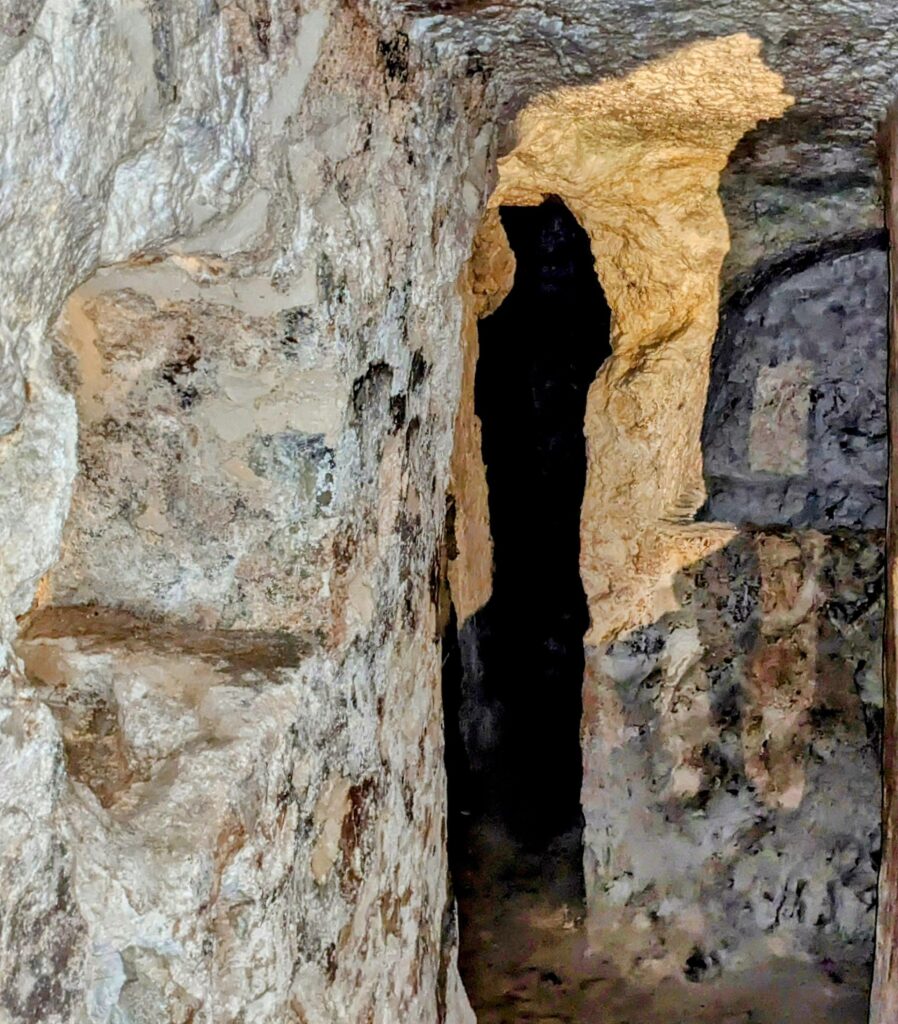
From a cultural perspective, even if one is not Catholic, it is worth visiting the country’s two cathedrals, St. John’s Co-Cathedral in Valletta (so named ‘co’ because it was one of two) and the Cathedral of St. Paul in Mdina. Although both are imposing in size, from the outside they are quite plain stone structures. Behind that modest façade, however, is a most richly decorated interior. It’s difficult to put in words just how crazily elaborate these cathedrals are. Gold everyone, chapels everywhere, paintings everywhere, elaborate stained glass windows everywhere. Truly, you just end up gawking. St. John’s was built by the Knights of St. John and intended to rival the great churches of Rome. It does a pretty good job of it. The Italian artist Caravaggio, who came to Malta after fleeing a charge of murder in Rome (!), has his own room there, where the massive ‘The Beheading of St. John the Baptist’ and ‘St. Jerome Writing’ are on display. St. Paul’s ceiling contains highly ornate frescos depicting the life of Paul, as well as many elaborate side chapels. If you haven’t quite your fill of churches, head to the Mosta Rotunda in Mosta – the third largest dome in the world.
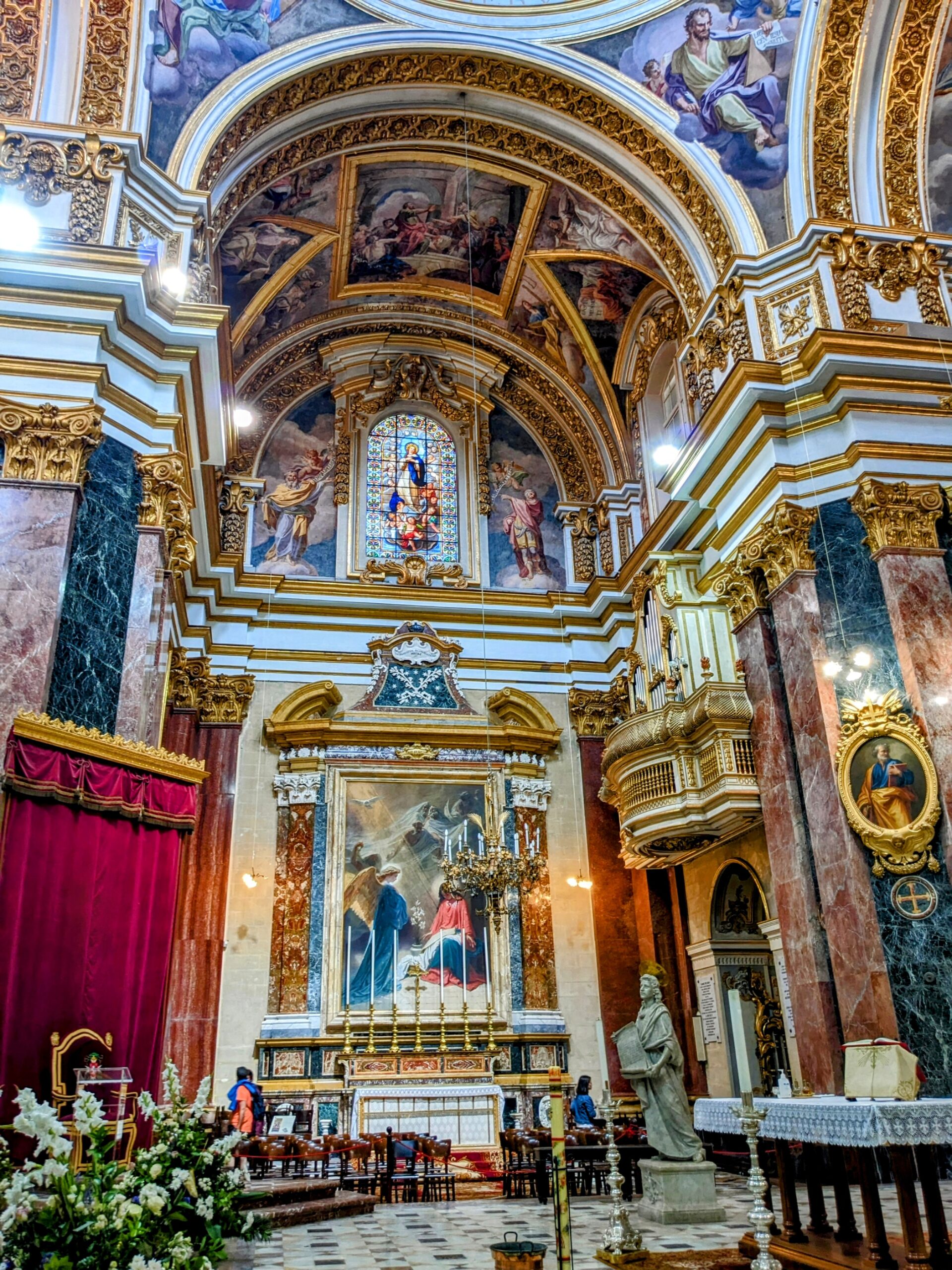
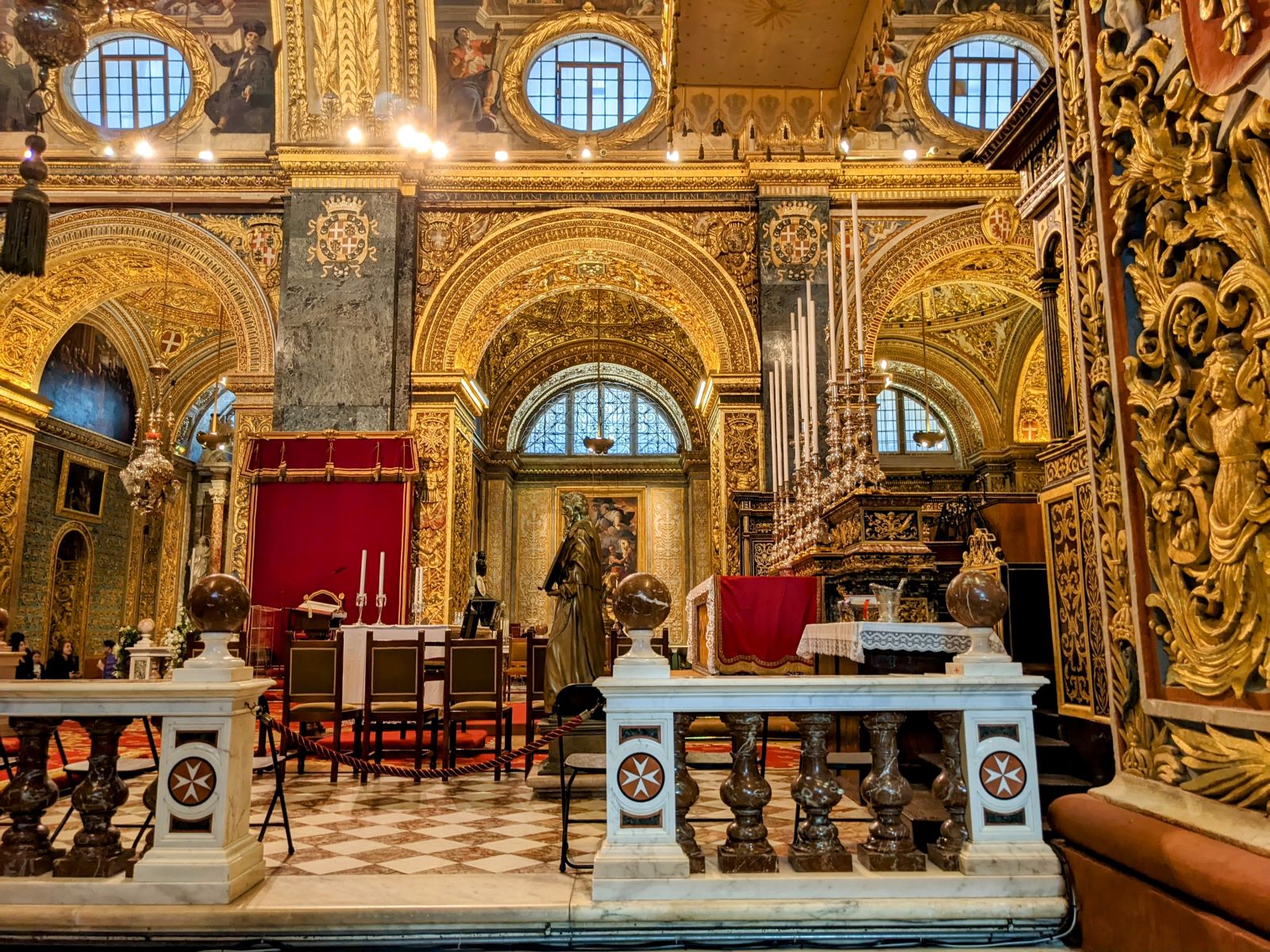
At left is the Cathedral of St. Paul in Mdina; at right, St. John’s Co-Cathedral in Valletta. Both depict the altar areas of the church. I kid you not when I say they are ornate.
I feel like I need to wrap up here. This has gone on way too long and I’ve probably lost a bunch of you along the way. Suffice it to say that if you ARE a beach-drink-eat visitor, there’s also plenty to interest you as well. Visit https://www.visitmalta.com/ and check it out. I’d like to go on a tour of the caves that dot the islands, and there’s a lagoon, snorkeling, tons of bays with tons of beaches and more. So really, check out the website.
Next trip? Cornwall and Oxford in England this summer (after a much-needed trip back to the states in late May-early June).
*Information about the temples came from several sources, but primarily the country’s Visit Malta website and the World History Encyclopedia.
***
Below are some random images and factoids without images that I didn’t have room for in the text:
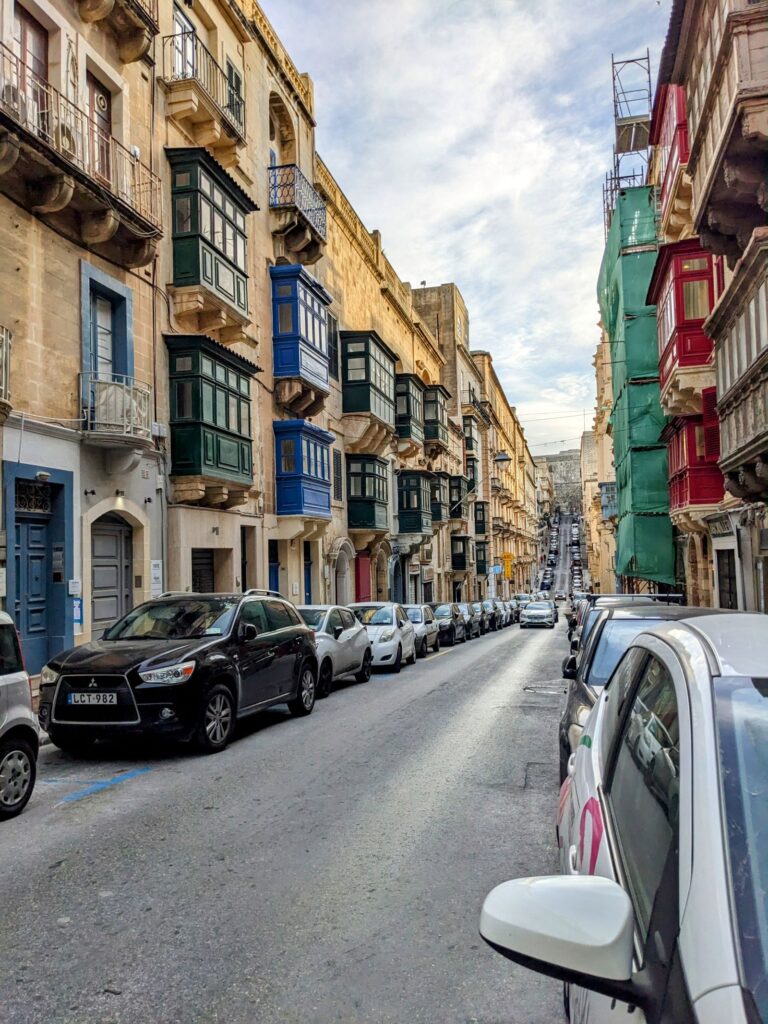
FOR YOUR INFORMATION: The gallarija – a covered balcony jutting out from just about every building – is certainly an architectural delight of Valletta. These gallariji are closely related to the mashrabiya, typical in Arabic architecture, and came into widespread use during the 17th century.
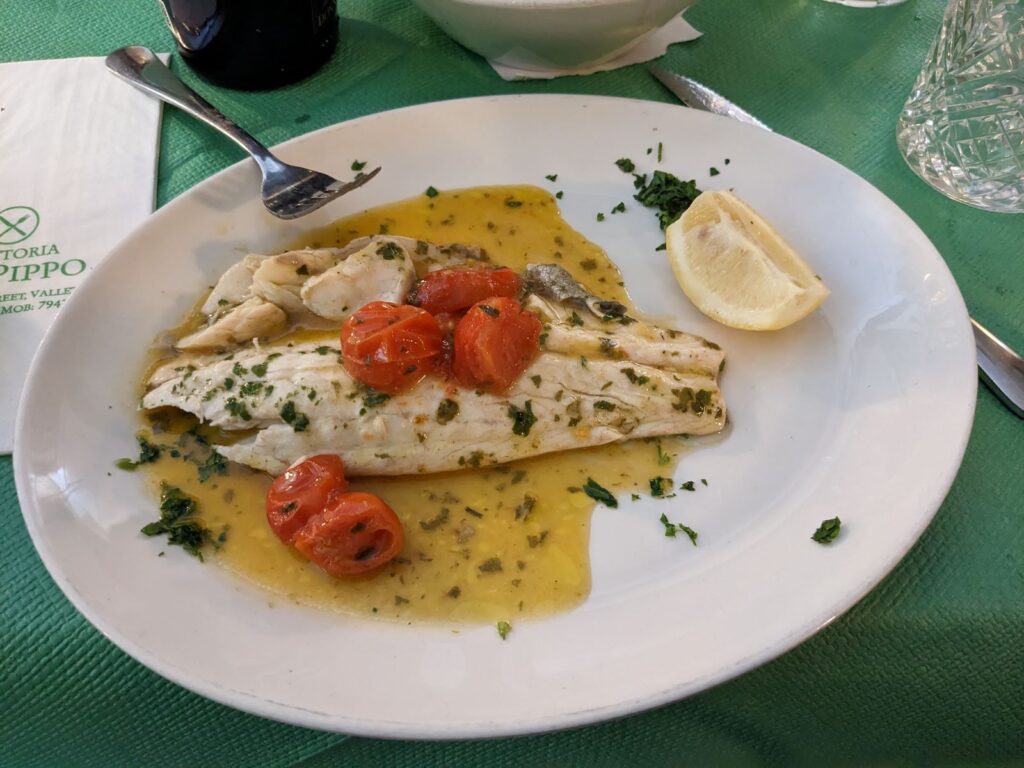
FOR YOUR INFORMATION: If you are looking for a special place to dine in Valletta, I’d like to suggest you check out Da Pippo Trattoria in Valletta. Da Pippo serves lunch only, but oh, what a lunch. There apparently is a menu, although I never saw one, but go with whatever the staff recommends. My friend and I had sea bass, unbelievably delicious, served with Patata il-Forn, thinly-sliced oven potatoes, and sautéd vegetables. I can still taste it all… While you’re waiting, take a gander at the photos that line the walls for all the famous folk who have dined there. You have to make reservations in advance, no walk-ins accepted. I emailed them a week before we arrived and heard back within a day. Here’s their Facebook page: https://www.facebook.com/dapippovalletta/
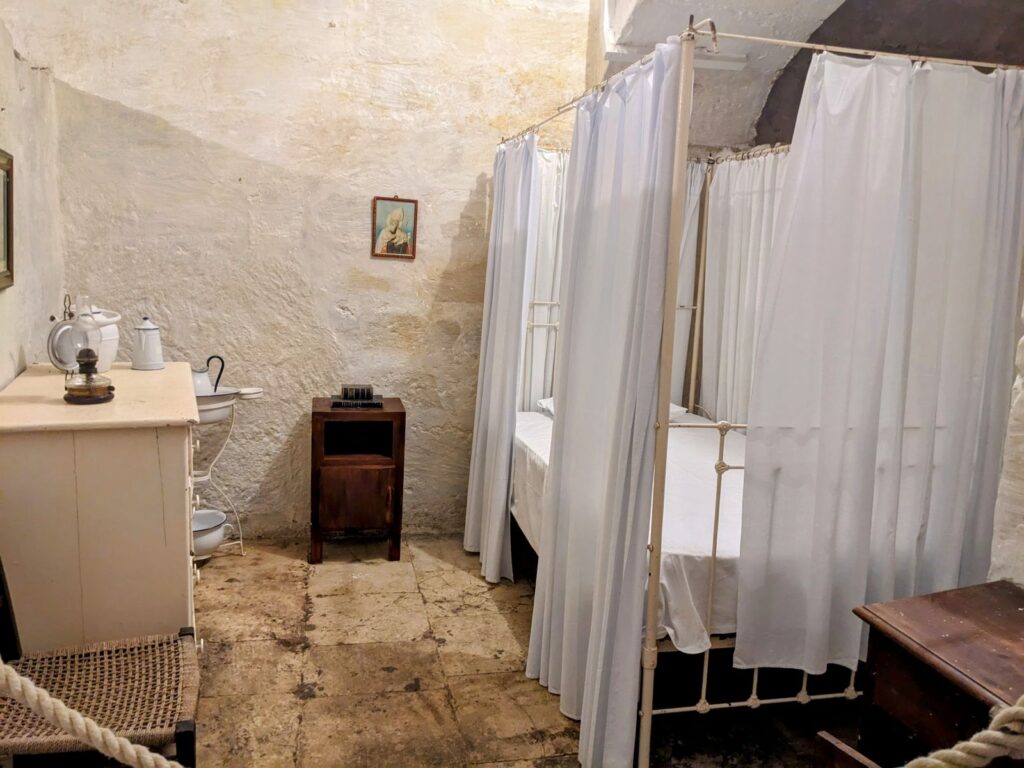
FOR YOUR INFORMAITON: One of the more interesting places we visited was Mysterium Fidei Museum in Valletta. Just recently opened, the underground complex is beneath St. Catherine’s Monastery, which still functions as a home for monastic nuns although few remain on the site. The monastery was founded in 1575 to care for female orphans. The underground complex was initially a quarry for the monastery above, but was turned into living space afterward. Above is a nun’s simply furnished room. It’s quite interesting and our tour guide was very informative. https://mysteriumfidei.mt/
FOR YOUR INFORMATION: World War II was devastating to Malta. Its proximity to Mussolini’s Italy, its status as a British subject nation, its closeness to the North African theater, all contributed to its strategic location. And the Germans (and Italians) took full advantage. The German bombing campaign was some of the heaviest of WWII, destroying roughly 80 percent of Malta’s buildings. For instance, on April 30, 1942, more bombs were dropped on Malta than in any one month during the Battle of Britain (from the Royal Air Force Benevolent Fund website).
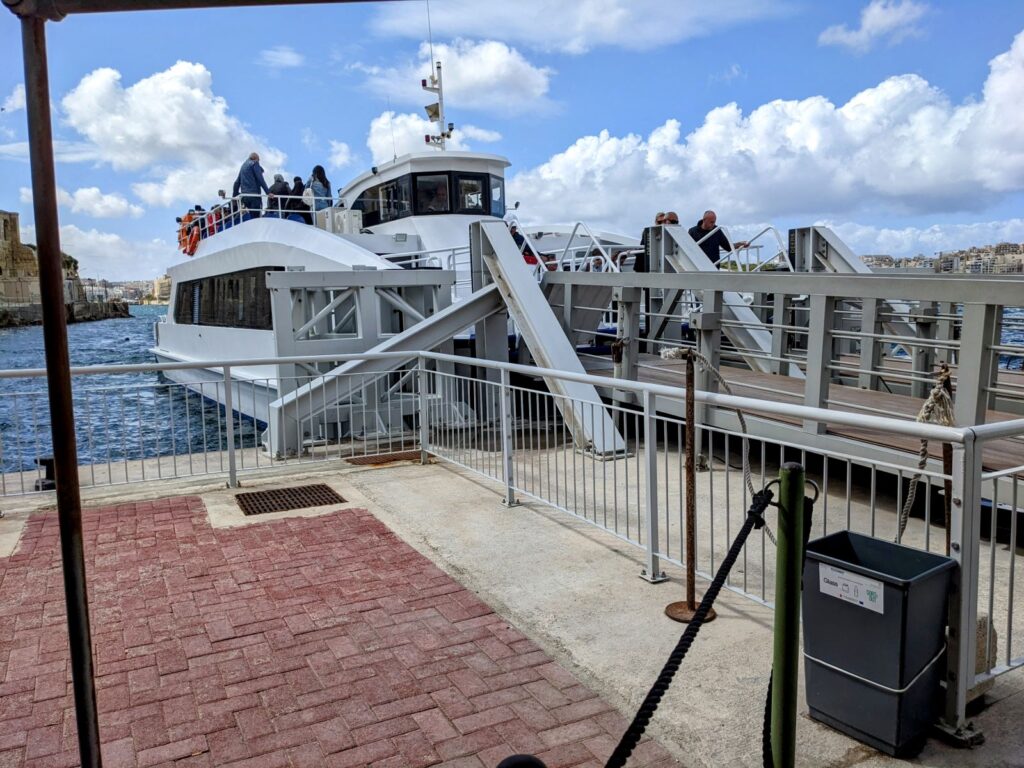
FOR YOUR INFORMATION: Getting around. My friend and I bought a public transport card for €21 our first day there, which entitled us to travel on all buses. You can get them at lots of different places. FMI: https://www.publictransport.com.mt/ We stayed in Sliema (pronounced Sleema), across Marsamxett Harbor from the capital Valletta, and there is a ferry service between the two municipalities. Round-trip, €2.80; seniors .50 each way. If I went back, though, I would rent a car, I think, as I spent a lot of time waiting for and riding in buses.
FOR YOUR INFORMATION: The English and Maltese languages are the official languages of the island. Although among the visitors when I was there, English was decidedly a minority language. A lot of French, a lot of German, Italian, Slavic languages.
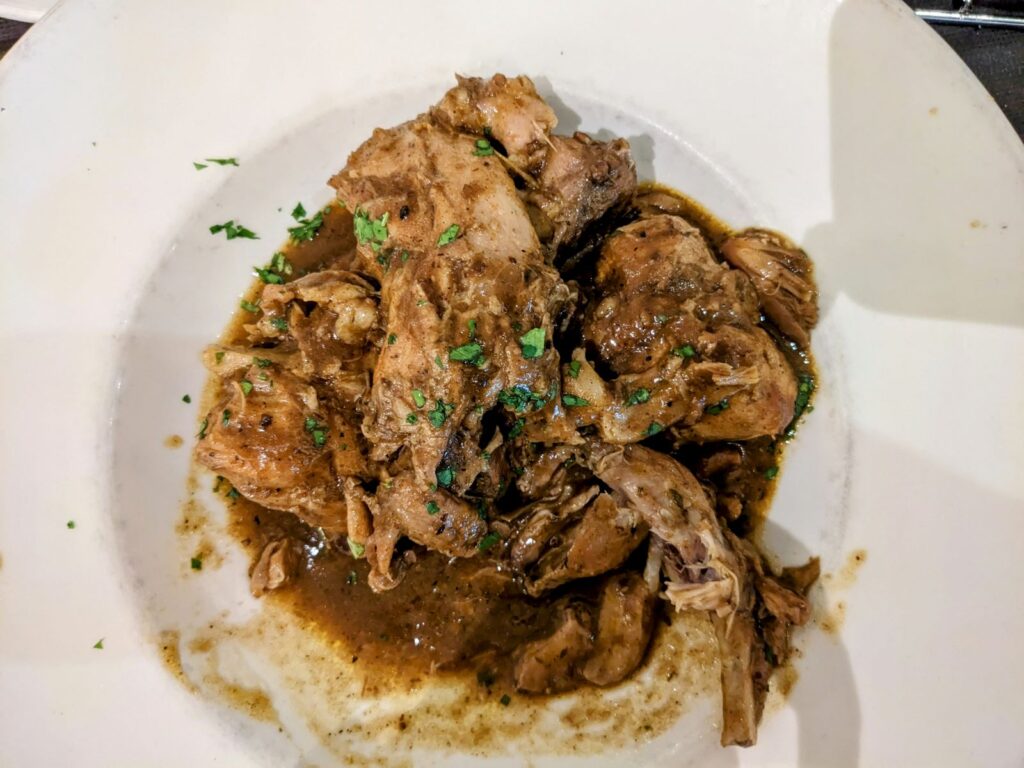
FOR YOUR INFORMATION: ‘Stuffat tal-Fenek,’ or stewed rabbit, is considered Malta’s national dish. You will find it on most restaurant menus and if you eat meat, do order it. It’s delicious. Apparently rabbits came with the Phoenicians a very long time ago, and quickly became part of the local diet. Here’s a recipe for it: https://airmalta.com/en/blog/malta/how-to-make-traditional-maltese-rabbit-stew
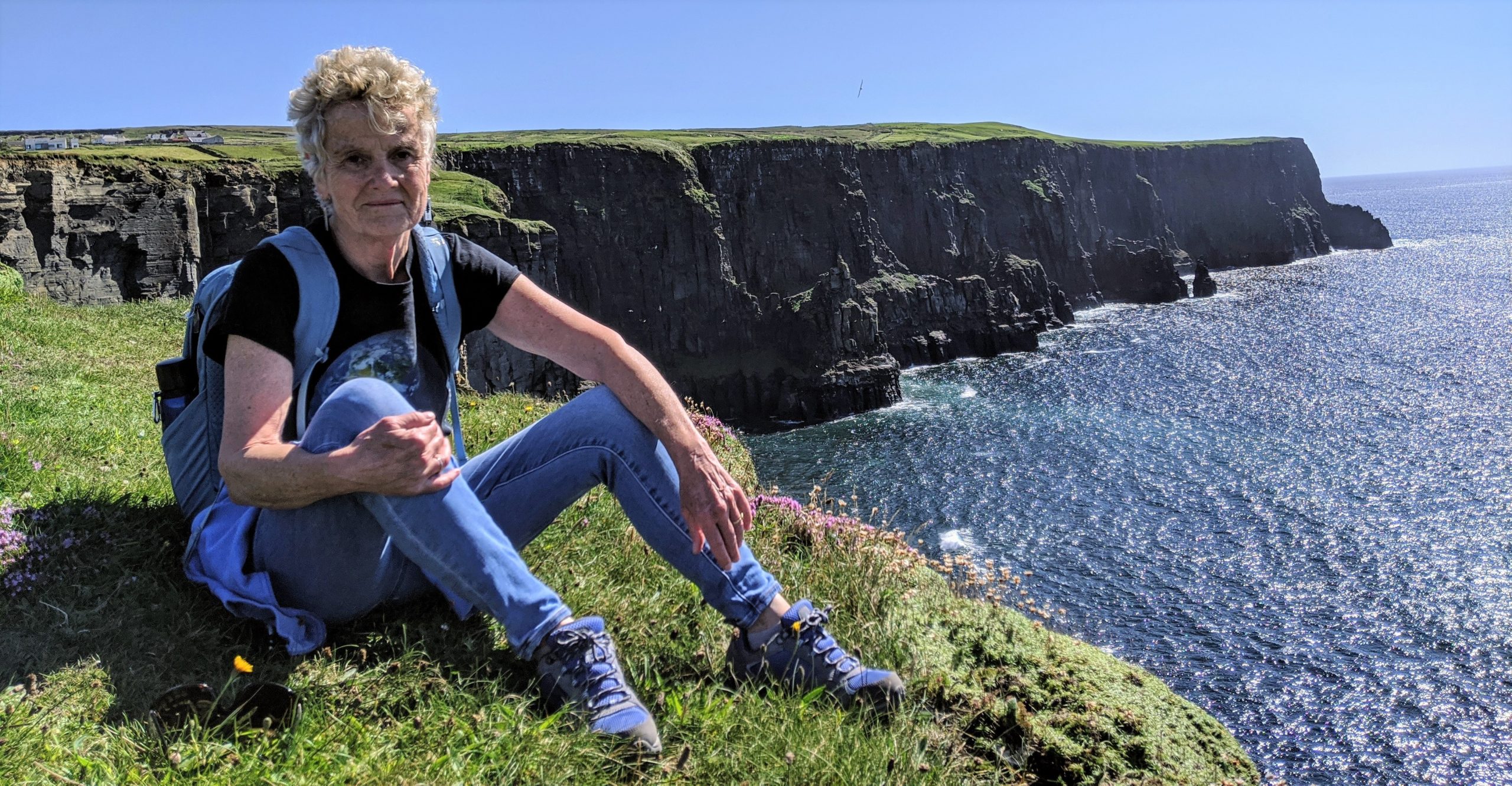
Reader Comments
This has been an exceptionally interesting read for me. I’ve heard of Malta but never had the interest or chance to dig into its history and culture at all. What a change for me! Your description of your trip has peeked my interest and I look forward to learning more about it. Pictures are wonderful and I’m hungry just thinking about those hideaway restaurants with scrumptious cuisine. Thank you for brightening up our rainy spring, cold days in Maine with your lovely travel journal.Marti
Deborah, I thnk you for sharing your wonderful trip to Malta. It sounds like you had a wonderful time and many great memories.
I recently sent a message to you in Facebook but I don’t know if you received it. I am currently working on planning a trip to Scotland for this year or next. I will be “woman travelling alone” and was wondering if you could answer some questions for me.
Hope to hear from you soon. Cheryl Wiggin
Yes, quite a magical little island – we were fortunate to visit in 2015 and you have brought so many memories to the fore – and included much more history! Thank you for that – keep truckin’, cuz!
Always a splendid travelogue …..
Keep sharing…I love traveling this way. I too would love to see the temples for the Goddesses!
I haven’t been there yet but Malta is historically fascinating. I was recently in Egypt where we were told that the Djoser Step Pyramid in Saqqura is the ‘first ever attempted colossal stone structure in history’ (2500 BC). No mention of Gjantija in Gozo!
I recently visited Stu Dawson. He isn’t as mobile as he once was but we hope to go to the Tiki Bar at the Marina for lunch soon. Tinker
Going to send on to my friend, Bernadette, who is from Malta. In fact she was there visiting her father while you were there. She will love this and so did I! xoxo
Thanks, Deborah, for all of this! It’s unimaginable that all this history could come out of that small country….which is now, kind of amazingly independent.
Guess I need that put it on my “bucket list”….
Great blog! (as they all are 😊)